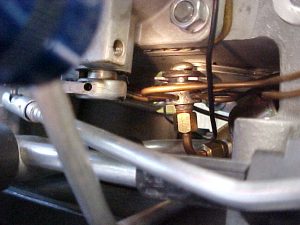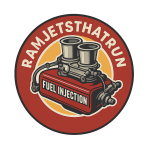Until November, 2011, I used pump premium gasoline for all my road testing and calibration work. Occasionally I’d get a bad tankful at some station and have to replace it with a different brand, but that happened only once or twice a year. Unfortunately, I consider those years the “good ol’ days”. Today the pump premium sold here in Mobile is unacceptable for use in Rochester injected Corvettes. Now I use undiluted racing gas exclusively in my test cars.
Modern pump gas can cause FI running problems throughout the RPM range. You’re probably familiar with the poor idle caused by percolation (boiling) of pump gasoline in the distribution spider. You may not have heard about the problems it causes during cruising and at high rpm though. Those problems are a little tougher to detect.
It took four hours on the chassis dyno for me to understand the Air / Fuel ratio differences between running modern pump gas and true racing gas. I was in shock by the end of that test session. I found that pump gas burns much leaner at idle (below 1,000 rpm) and high rpm (above 4,000 rpm) during hot weather than racing gas. Oddly, pump gas burns richer than racing gas at legal cruising speeds (30 to 70 mph). This means that although your car will run on pump gas, it won’t run its best. In the summer your idle will be rough after the engine is fully warm, and you’ll foul spark plugs more frequently while cruising. This also means sustained engine operation (many minutes) at very high rpm (above 5,000 rpm) with pump gas could burn a hole in a piston or a head gasket on a hot day.
Here’s my opinion why modern pump gas doesn’t calibrate properly in old Rochester FI units. Gasoline is a mixture of many components. These components have different physical characteristics. Some are “light ends”, and vaporize at relatively low temperatures at atmospheric pressure. This fact isn’t apparent when you see the published vapor pressure of gasoline because it’s an average for the entire mixture.
At idle, the distribution spider is only pressurized to 0.25 pounds per square inch. This is very near atmospheric pressure. A significant portion of modern pump gasoline will vaporize inside a hot spider hub at such a low pressure. This causes the Air / Fuel mixture at the nozzles to go lean. It may not be lean enough for your seat-of-the-pants gauge to detect, but I can certainly see it going lean using the dynamometer control panel instrumentation.
The high speed lean-out is caused by a similar, but different, vaporization problem. All pumps need a certain amount of feed pressure on the suction side to maintain liquid flow at the design pumping rate. If this feed pressure (called “Net Positive Suction Head”) is less than required by the pump design, the incoming liquid will partially vaporize into bubbles. It’s called “pump suction cavitation” when this happens. Bottom line: a pump that doesn’t have enough Net Positive Suction Head will not flow as much liquid as it should.
The amount of Net Positive Suction Head is determined by the height of the liquid feeding the pump suction side and the physical properties of that liquid at pumping temperature. Hot modern pump gasoline less than 3″ high in the fuel bowl doesn’t provide squat for NPSH. I can see exactly when gear pump cavitation starts while watching the dyno control panel. On a hot day, it can occur as low as 4,000 rpm under full acceleration load. It only gets worse as the rpm’s climb. By 5,000 rpm, cavitation can cause a mixture as lean as 18:1. That’s lean enough under load to hurt some engine parts if you don’t take your foot out of it.
Pump gas burning richer than racing gas while cruising is not a big shock to me. After all, octane rating is often indirectly related to volatility. Because it is more volatile, I believe modern pump gas burns more efficiently than racing gas at relatively low engine compression ratios. Running slightly rich while cruising won’t cause any major problem. It may foul spark plugs a little sooner than running the right A/F ratio, however.
You can run 100LL Aviation gasoline, but it won’t help much. Those special gasoline additives sold at auto parts stores don’t have any significant effect either. Neither does the additive sold at swap meets that is 99% kerosene. I’ve tried the thick, one-piece, plenum to baseplate gasket too. It was no help. Insulating the gas line from the engine fuel pump to the FI fuel meter makes things worse. The best course is to just run 100% racing gas. I use the VP brand with a 110 octane rating, but other brands of racing gas would probably work just as well. I tried cutting it 50% with pump premium to save money, but the running problems were still there.
CLIFF’S VERSION: Your FI unit will start and cruise on modern pump gas, it just won’t idle consistently at 800 rpm or perform its best in hot weather unless you run racing gas. This is due to pump gas boiling in the spider. I know of no FI modification or fuel additive that will completely prevent pump gas boiling at very low nozzle pressures during hot weather.

